Best acoustic guitars for beginners 2025: My top picks for new players, reviewed by a pro
I've tested epic affordable six-strings from Fender, Taylor, Yamaha, and more – read on for my best beginner acoustic guitar recommendations and watch my video demos

Purchasing a beginner acoustic guitar is a milestone you'll cherish. To find the best acoustic guitars for beginners, it's essential to consider a few key factors. Look for playability, as a comfortable neck and action will help you learn more easily. The guitar’s size matters, too. Smaller models are better for children, while larger ones provide a fuller sound for adults.
With nearly a decade of experience as a music retail manager, I've assisted countless new players - and their parents - in choosing their first instrument. Now, as a full-time writer for Guitar World, I'm going to share my insights and experience with you.
I’ve gone to great lengths to provide as much information in this guide as possible to ensure you make the correct choice. Along with detailed reviews of each starter guitar, you’ll also find a video demo for each of our top picks. For the videos, I played each guitar at various dynamic levels so you can compare and contrast the sonic qualities of each instrument. I’ve even included sizing photos so you can see how large each model is – particularly useful if you're purchasing a guitar for a child or you're a smaller player. For reference, I'm 5'11".
My top pick for the best acoustic guitar for beginners is the Fender CD-60S, which balances affordability and playability. For younger players, the Gretsch Jim Dandy is an excellent choice due to its petite frame. For me, Adults seeking a more mature tone should consider Yamaha’s classic FG800.
Now, don’t be intimidated by acoustic guitar terminology; I've included a glossary to help clarify key terms, along with a FAQ section that addresses common beginner acoustic questions. If you're more experienced, my guide to the best acoustic guitars offers options for various skill levels.
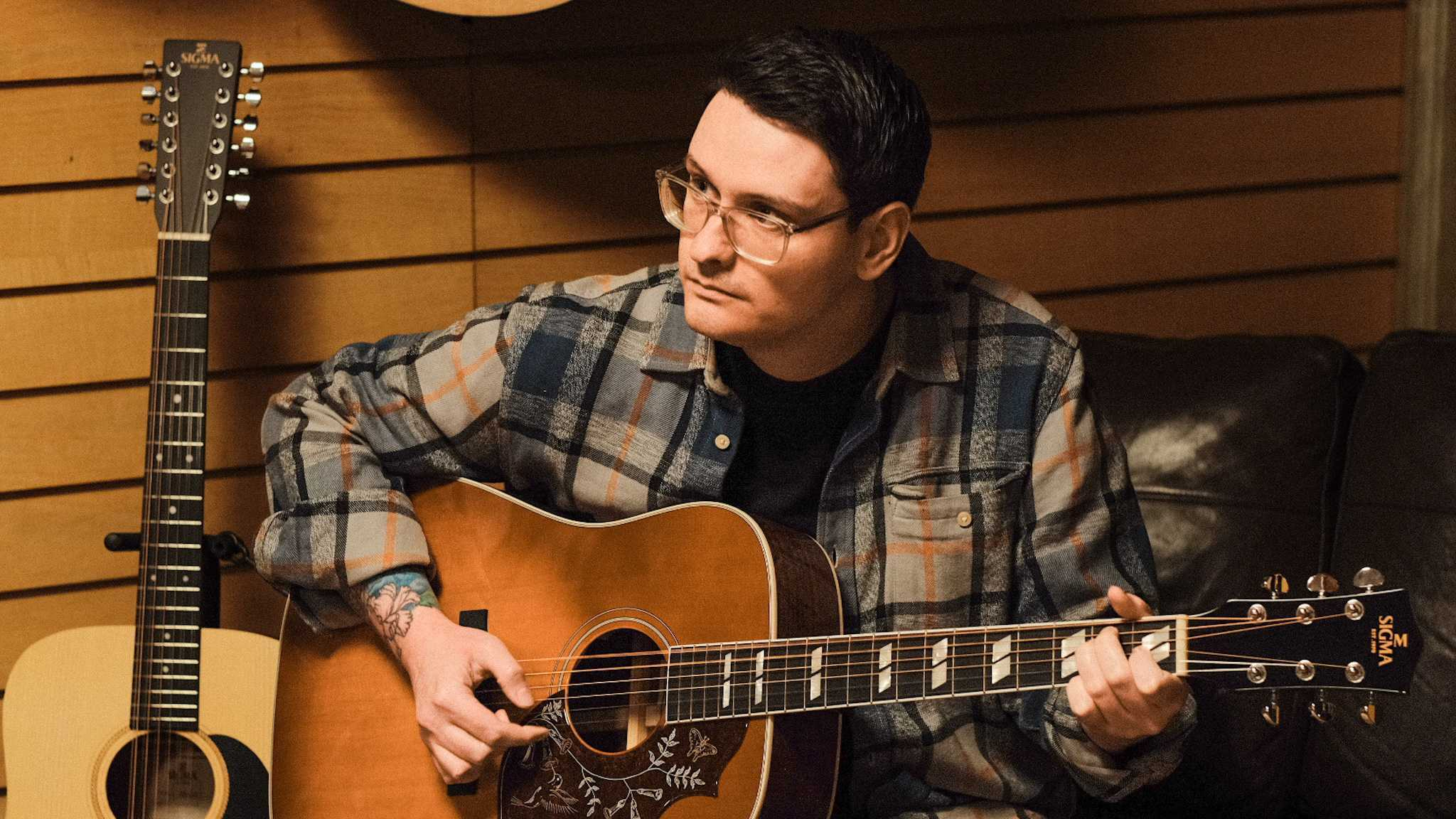
"For me, a great acoustic guitar for beginners should be both inviting to play for newbies and sound good enough to keep their attention, all while being affordable and accessible to the majority of rookie guitarists – in my opinion, every instrument I've included in this guide delivers this."
How I tested: Each guitar was thoroughly tested by either me or another member of the Guitar World team, paying careful attention to everything from build quality and tone, to playing action, finishing and lastly, value. Read more on how we tested the products for this guide.
Quick list

With this Fender, you have a leading brand producing an excellent acoustic guitar at an entry-level price. In our tests, we found that this dreadnought’s all-mahogany construction produced a full, rounded sound with playability to match.

We have to start by saying we absolutely love the look of the Gretsch G9500 Jim Dandy. Its small stature and stunning finish just oozes vintage charm. That said, to be included in this best acoustic guitars for beginners guide, it needs to go deeper than just good looks – thankfully the G9500 more than delivers.

One of the lowest-priced guitars in our guide, Yamaha’s FG800 is a seasoned veteran in the beginner acoustic field. The sound generated by this beauty could easily come from a more expensive guitar, and it’s reliable at holding its tune, too.
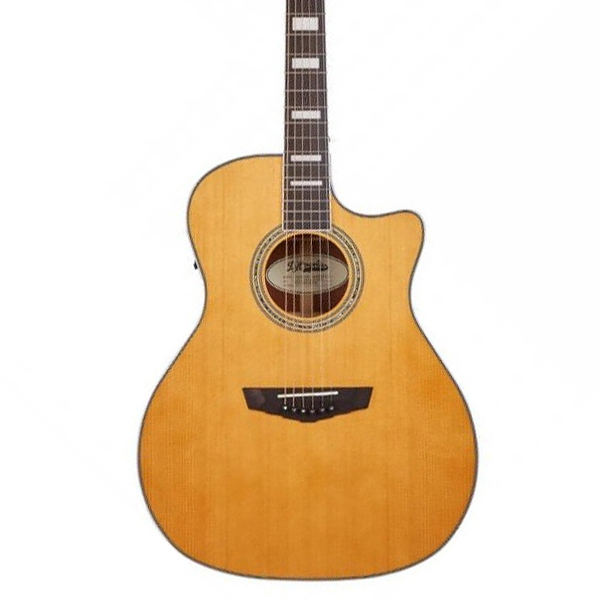
Well-made, easy to play and with a visual flare that makes it stand out from the crowd, D'Angelico’s Premier Gramercy isn’t your average acoustic guitar for beginners, that’s for sure.

At around the $270 mark, the Alvarez AD30 is another dreadnought delivering well above its diminutive price tag. It kicks out significant volume from its sitka spruce body, which is as warm in tone as much as it is bright.

Taylor’s GS Mini doubles as a travel-sized guitar and dishes out all you need for home playing, especially for younger or smaller guitarists. The factory-set action is low, making it simple to play from the get-go.
Best overall


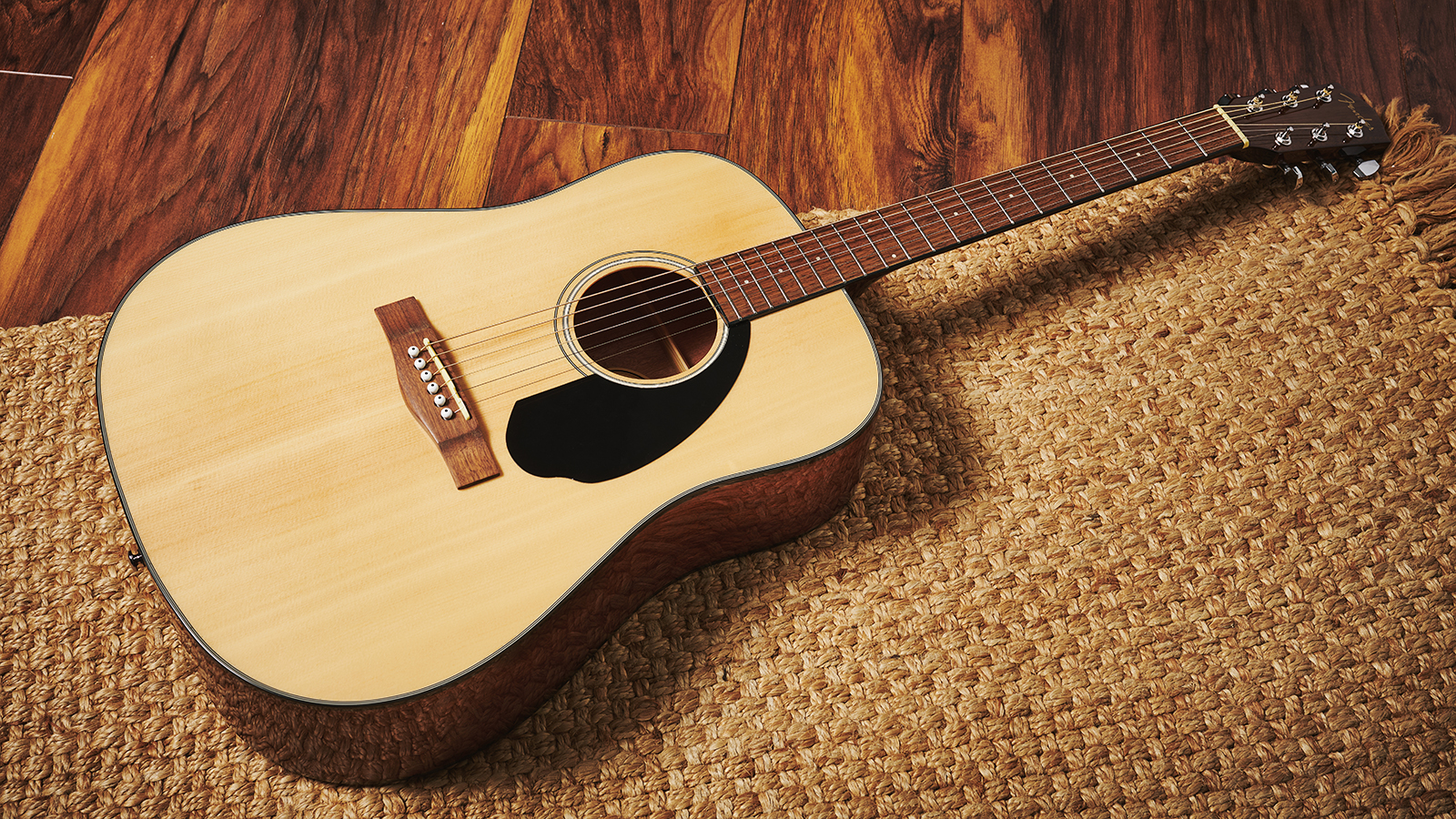


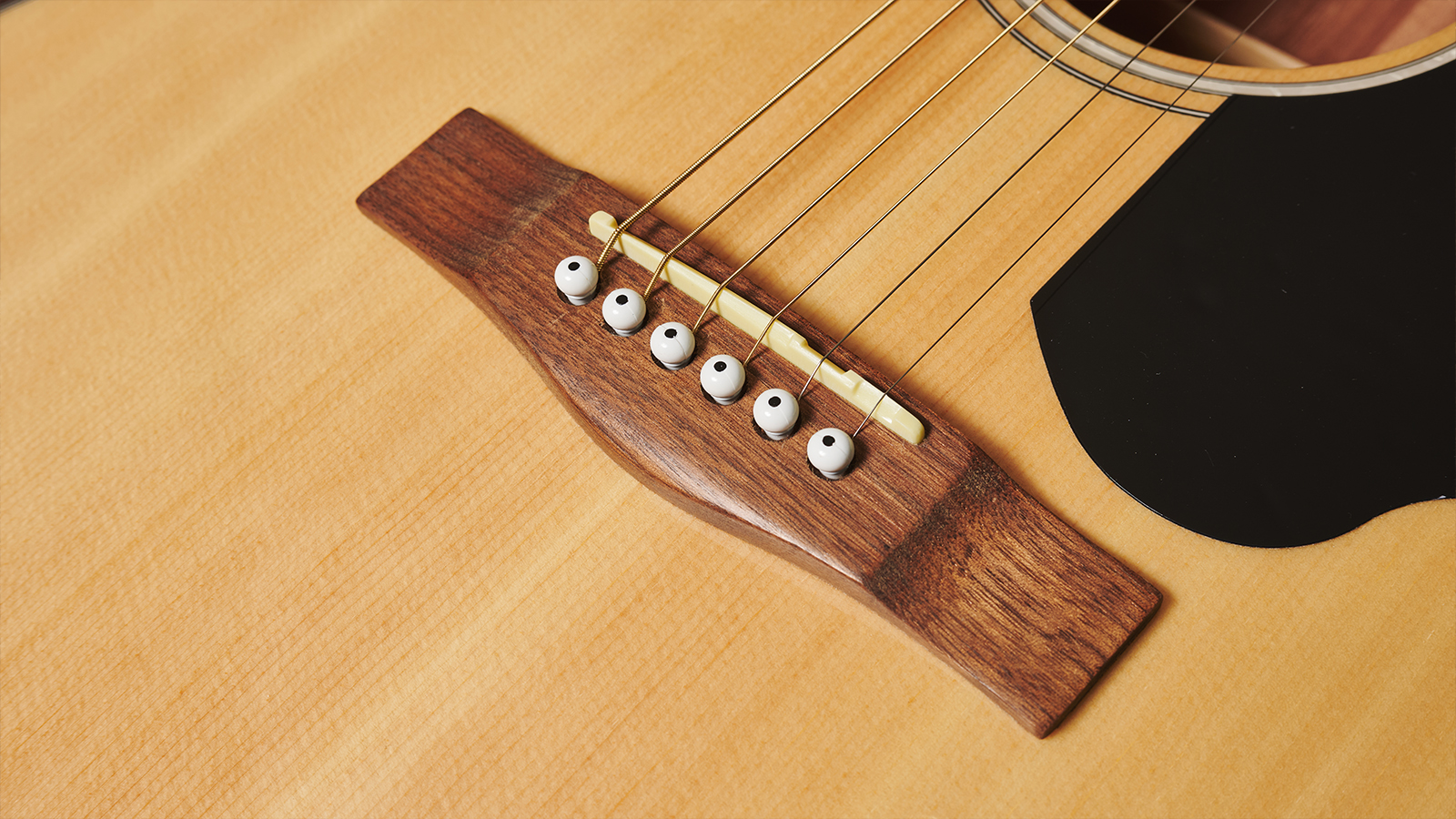
Specifications
Reasons to buy
Reasons to avoid
✅ Buy If you want a big-name brand on a budget: Fender is the biggest name in the business, and the CD-60S is the perfect entry-level guitar from this legendary guitar maker.
❌ Avoid if you are small or don't like large guitars: The dreadnought body of the CD-60S produces a massive sound, but it can be a little too large for some to hold.
Value: ★★★★★
Playability: ★★★★☆
Sound: ★★★★☆
Overall: ★★★★★
In a nutshell: With this Fender, you have a leading brand producing an excellent acoustic guitar at an entry-level price. In my tests, I found that this dreadnought’s solid top construction produced a full, rounded sound, which equates to volume and confident mid-level power in support of a bright treble.
Who is it for? As this is a dreadnought guitar, it's more suitable for adults or older kids due to its size and scale. For younger players, we recommend checking out the next entry in this guide, the Gretsch Jim Dandy, as it's more tailored for children and provides a better playing experience for them.
Build: I was very impressed with how well this model was put together. As you can imagine, I've played a number of guitars in this category, and this is easily one of the best starter acoustic guitars I've had in my hands. The tuners are smooth and reliable, and at the sub-$200 mark, they represent excellent quality compared to other guitars in this bracket. Previously, Fender’s acoustic guitars for beginners had an action that tended to be on the high side. But the CD-60S has an action low enough to enable easier playing while avoiding troublesome fret buzz. The finishing is on point, too. Our review example had a clean, well-applied finish, which gives the guitar a nice shine.
Performance: In our review, we said, “Crucially for a beginner’s acoustic, Fender gets the neck profile bang on. The CD-60S is a joy to play, and backs this up with an impressive tone, making chords sound full and wide, yet with a detailed midrange and a vibrant top-end that adds a little magic to the mix.” High praise indeed for just an affordable acoustic guitar. We genuinely love how this guitar feels to play. The neck is slim, inviting, and very easy to navigate.
In terms of tone, the CD60S is warm, mellow, with a pronounced midrange and plenty of volume. In our review, we said, "chords sound full and wide, yet with a detailed midrange and a vibrant top-end that adds a little magic to the mix."
Watch my Fender CD-60S demo

“I found the CD-60S to be one very playable dreadnought with a wide, well-balanced tone that belies its modest price. Ideal for beginners – fun for all.”
Read more: Fender CD-60S review
Best for kids

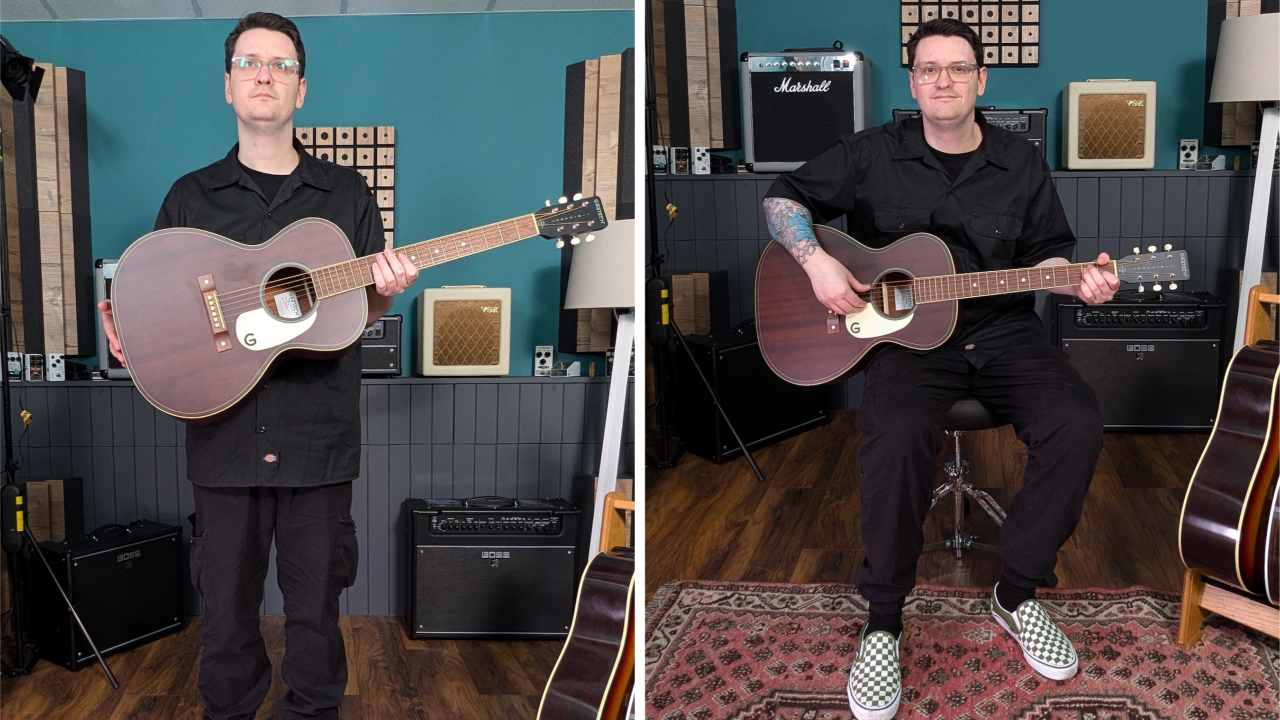
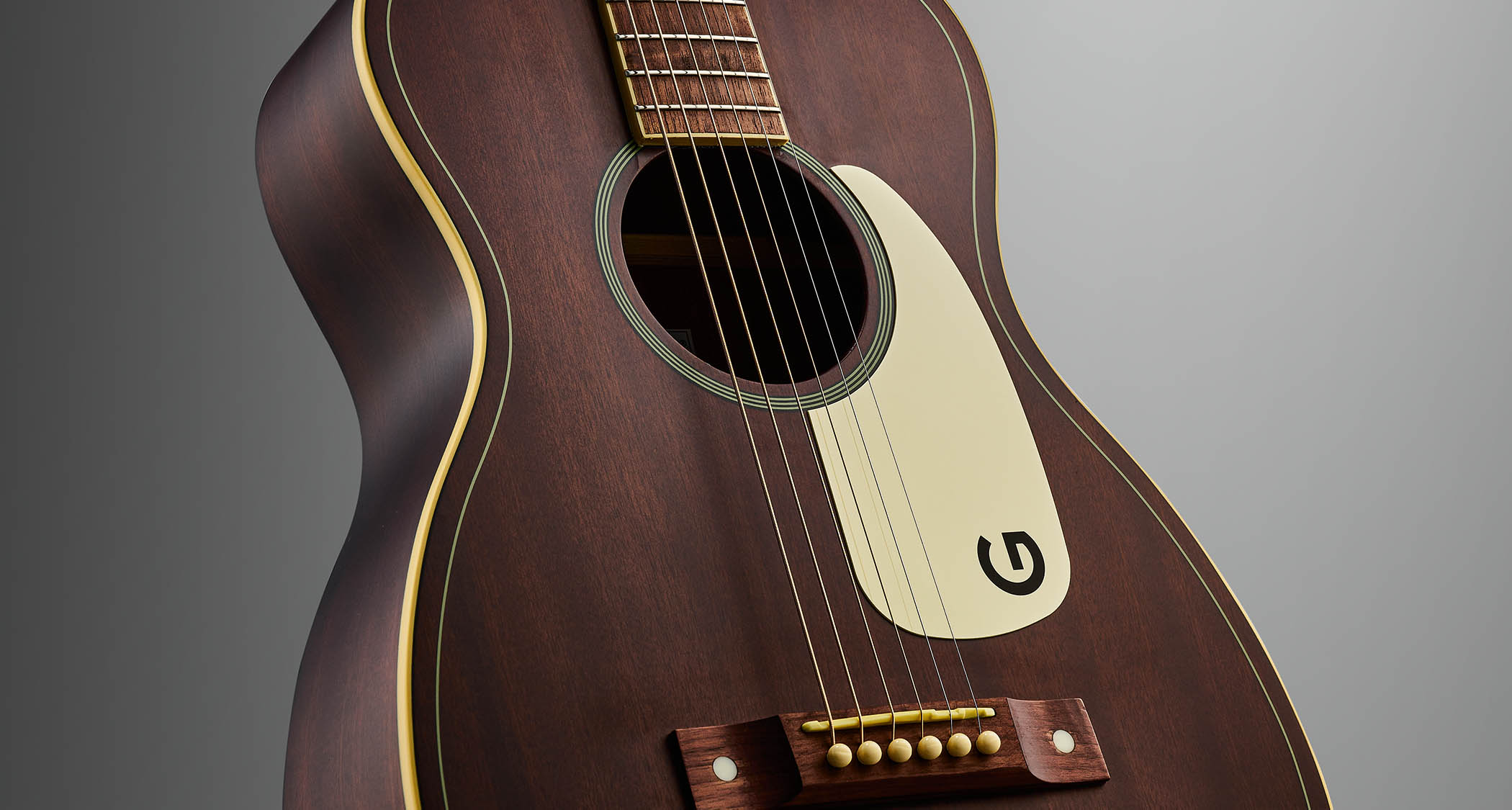


Specifications
Reasons to buy
Reasons to avoid
✅ Buy if you want a traditional-sounding guitar: The Jim Dandy has plenty of retro charm and a sound to match. It's warm and full of character.
❌ Avoid if you need onboard electronics: If you are after a guitar you could eventually play on stage, we recommend looking at a model with a built-in pickup system.
Value: ★★★★☆
Playability: ★★★★☆
Sound: ★★★½
Overall: ★★★★½
In a nutshell: I have to start by saying I absolutely love the look of the Gretsch G9500 Jim Dandy. Its small stature and stunning finish just oozes vintage charm. That said, to be included in this guide to the best beginner acoustic guitars, it needs to be more than a good-looking guitar – thankfully, the G9500 more than delivers.
Who is it for? This is currently my top pick for kids and smaller teens. Looking for more options for your little one? Check out my full guide to the best guitars for kids.
Build: Neat and tidy, this Gretsch is very well put together indeed. The frets are well dressed and expertly installed, and the finish is gorgeous. In our review, we said, "As we take ours out of its box, it’s noticeable that the Nocturne Blue doesn’t just look good in the photos, and if you’re worried about those tuners being a bit Meccano, you’ll be pleased to hear that the Jim Dandy turned up with its tuning almost perfectly intact."
Now, this guitar is rather small and may be too small for adults or older kids. So, please bear that in mind when you are making a purchase. For adults, we suggest looking at either the Fender CD-60S or the Yamaha FG800.
Performance: In our review, we noted just how impressed we were with the guitar's low action and how well-intentioned it was across the neck. Tonally, it’s as you might expect. Obviously, the reduction in body size also means that it’s not going to have the bass and resonance levels of a standard dreadnought. Instead, the tone is bright but not brash when strummed, and fingerpicked notes have a definite ‘pluck’ to them, with a strong attack and slightly reduced sustain.
There aren’t many acoustic guitars that are this much fun to play, and even fewer from respected names at this price point, making it an easy recommendation from us at Guitar World.
Watch my Gretsch Jim Dandy Concert demo

“With stunning looks, a short scale length and modest price tag, I feel this is an ideal guitar for younger players and adults alike.”
Read more: Gretsch G9500 Jim Dandy review
Best for adults


Specifications
Reasons to buy
Reasons to avoid
✅ Buy if you are seeking superb build quality: For us, Yamaha offers the best build quality at this price point. Their guitars are impeccably finished and well-made.
❌ Avoid if you need onboard electronics: Unfortunately, this model does not come loaded with a preamp or pickup.
Value: ★★★★★
Playability: ★★★★☆
Sound: ★★★★★
Overall: ★★★★★
In a nutshell: One of the lower-priced guitars in our guide, Yamaha’s FG800 is a seasoned veteran in the beginner’s acoustic field – but don’t let that small price tag fool you.
Who is it for? The Yamaha FG800 is our top choice for adult beginners looking for an acoustic guitar, as we think the simple finish and larger body size make it perfect for older players. While the neck has a rounded, comfortable profile, the body is rather large, so young kids will want to avoid this model for sure.
Build: Yamaha has a reputation for crafting well-made products, no matter the category - be it motor bikes, speedboats, pianos, or, in this case, entry-level acoustic guitars. This guitar is built like a tank. It may be at the bottom end of Yamaha’s range, but that doesn't mean it can't be kitted out with more premium features. For example, the inclusion of a solid spruce top may surprise many players who are used to seeing all laminate guitars at this price point.
Performance: In my time in music retail, I must have sold hundreds of these guitars over the years, but while filming the demo videos for this guide, I was reminded just how good this model sounds (a reaction mirrored by our cameraman and sound guy, too). The sound generated by this beauty could easily come from a more expensive guitar, and in use, it’s reliable at holding its tune, too.
A solid spruce top, more usually found on higher-priced guitars, helps create an impressive tone. And we think it really is the sound that allows this guitar to stand out from the others at the sub-$200 mark. No amplification is included, but for this price, who’s complaining?
Watch my Yamaha FG800 demo
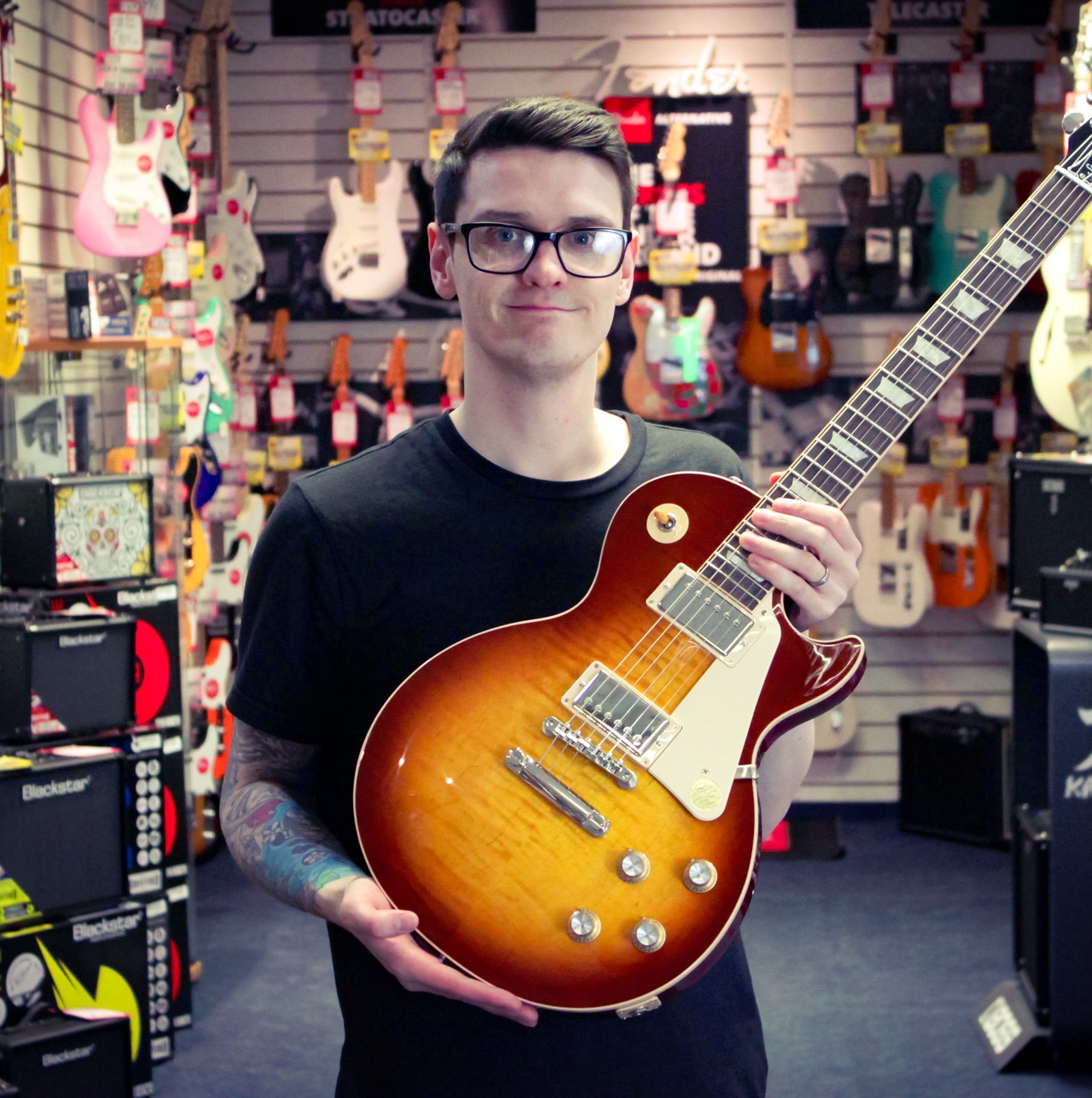
“There’s no doubt about it, the Yamaha FG800 is one of the greatest beginner acoustic guitars of all time. Its solid top helps deliver a rich, full-bodied tone usually reserved for more expensive instruments. In addition, the smooth neck is comfortable, extremely playable, and perfect for players at the beginning of their musical journey.”
Read more: Yamaha FG800 review
Best with a cutaway



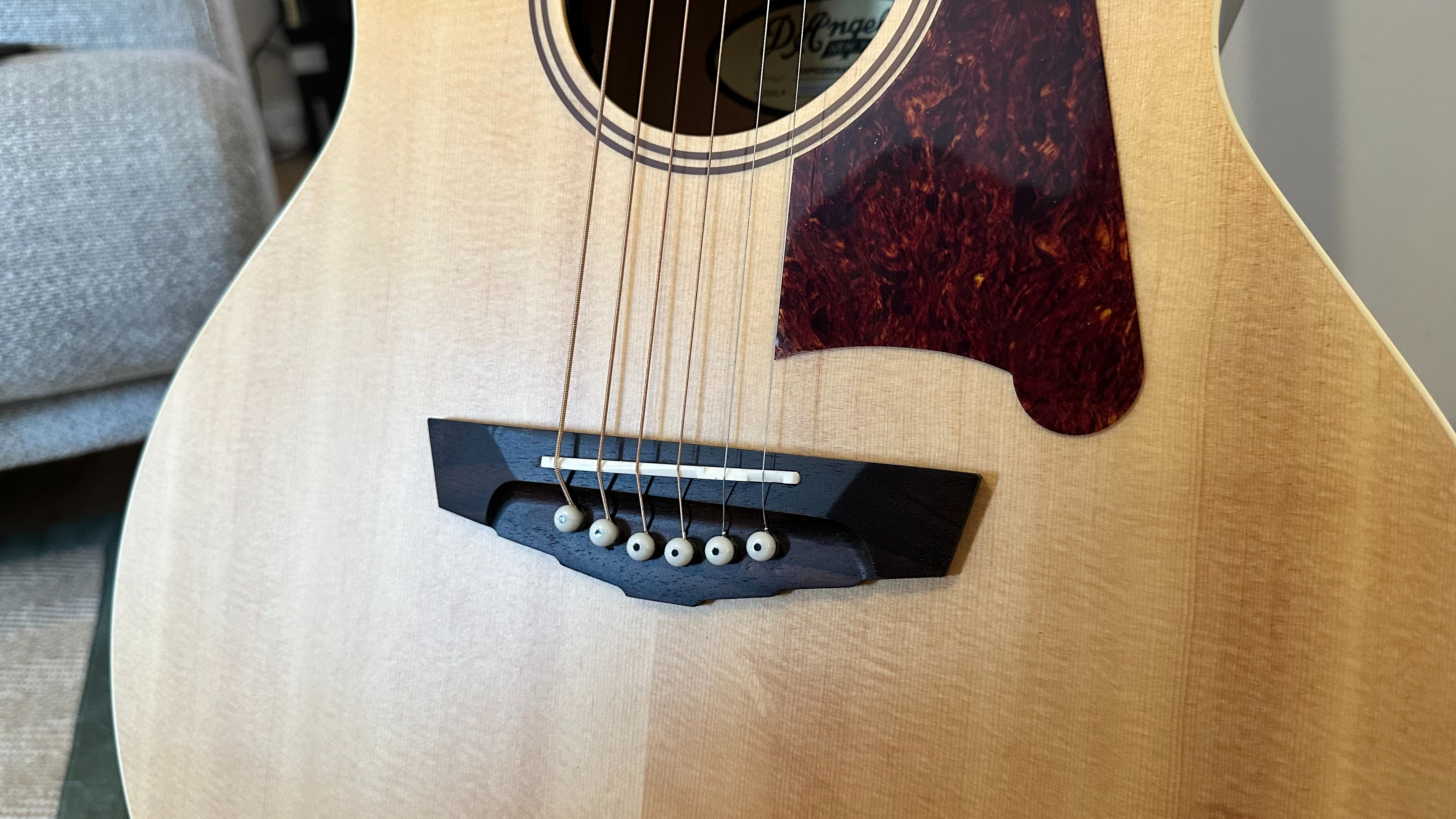


Specifications
Reasons to buy
Reasons to avoid
✅ Buy if you want superior upper-fret access: As this guitar has a cutaway design, it is ideal for those who want to play lead parts higher up the fingerboard.
❌ Avoid if you don’t like bright-sounding guitars: This guitar has a very crisp tone that some may find a little abrasive at times. If you prefer a warmer tone, you may want to opt for a different model.
Value: ★★★★☆
Playability: ★★★★☆
Sound: ★★★★☆
Overall: ★★★★☆
In a nutshell: Well-made, easy to play, and with a visual flair that makes it stand out from the crowd, D'Angelico’s Premier Gramercy isn’t your average acoustic guitar for beginners, that’s for sure.
Who is it for? This guitar is ideal for adults and older teenagers, particularly beginners seeking a model that will grow with them.
Build: Featuring a grand auditorium-shaped body, this single-cutaway guitar is ideal for players with a slightly smaller frame, while the common use of a solid spruce top and sapele back and sides delivers a bright and articulate attack that to my ears sounds just as good strummed with a pick as it does played with purely your fingers.
Performance: To me, this beginner acoustic guitar has a stellar tone to match its charming appearance. Bright yet full, this guitar has a tone that just makes you want to play more. Now, I think it’s important to think past the beginner stage when choosing a guitar. If your budget allows it, you should most definitely consider purchasing a guitar that’s more future-proof. Thankfully, this D’Angelico fits that brief. Coming loaded with a discreet Fishman pickup system, this stunning beginner acoustic is stage-ready right out of the box.
Watch my D'Angelico Premier Gramercy demo

“In my opinion, the D’Angelico Premier Gramercy is, undoubtedly, a fine guitar for the money. It is well-made, sounds decent, and looks interesting. Some players may find the tone on the bright side, but it can't be denied that the Premier Gramercy offers outstanding value for players of all levels.”
Read more: D'Angelico Premier Gramercy review
Best value



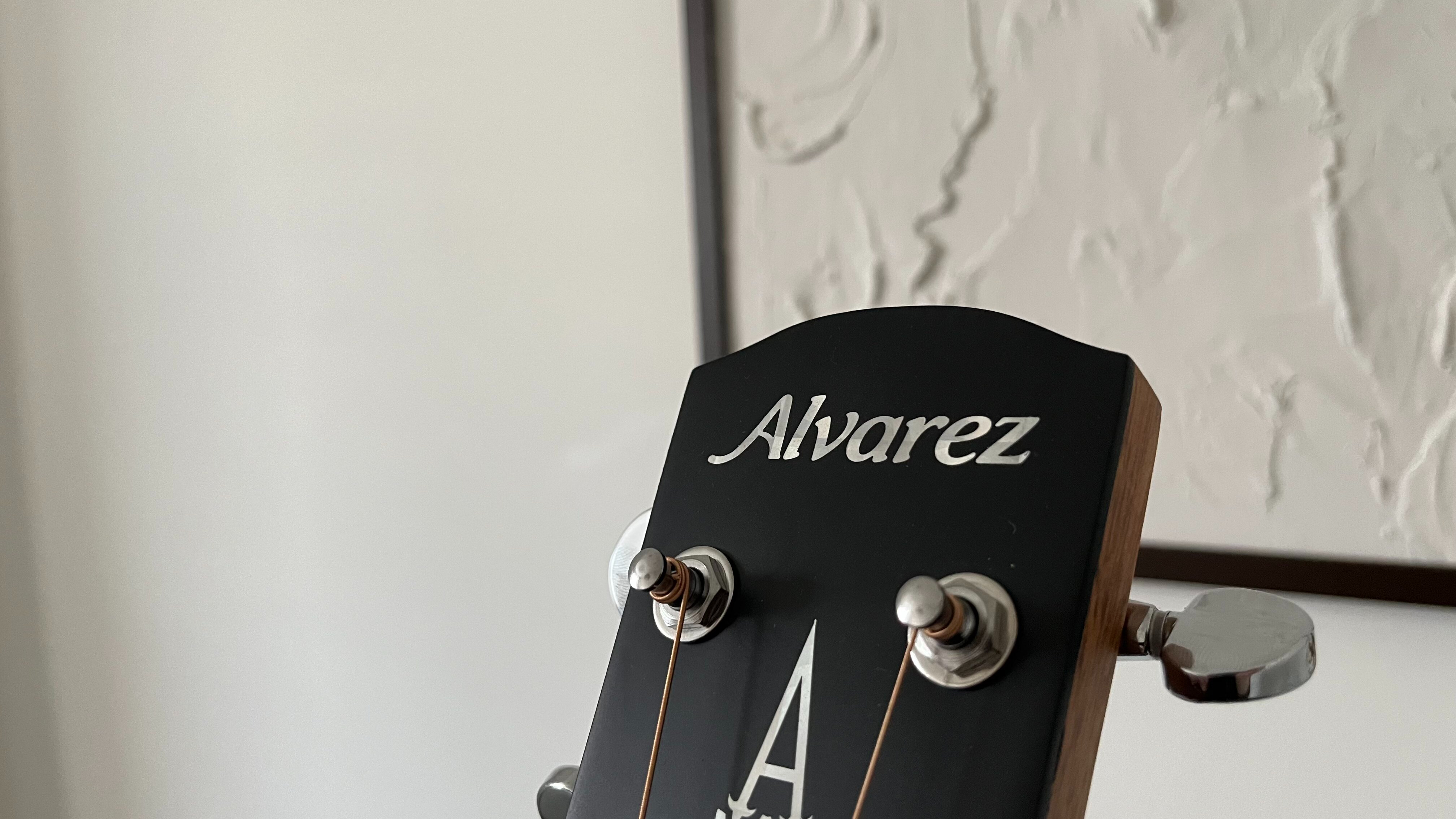


Specifications
Reasons to buy
Reasons to avoid
✅ Buy if you want volume and power: This guitar is bright, loud and powerful. We absolutely love the sound of this guitar, and we believe you will too!
❌ Avoid if you don't like dreadnought guitars: We are aware that dreadnought guitars aren’t for everyone. Some don't like the large body, and if that's you, we recommend a concert or folk-sized guitar.
Value: ★★★★★
Playability: ★★★★☆
Sound: ★★★★☆
Overall: ★★★★☆
In a nutshell: At around the $270 mark, the Alvarez AD30 is another dreadnought delivering well above its diminutive price tag. In my tests, I found that it kicks out significant volume from its sitka spruce-topped mahogany body, which is as warm in tone as much as it is bright.
Who is it for? To me, this is very much an adult's acoustic guitar. It has a mature look, tone, and feel, making it ideal for older players.
Build: The guitar's construction is rugged, and it stays reliably in tune. The 50/50 gloss to matte finish on the neck balances resilience with ease of playing. Conventional rather than flashy, the AD30 is a reliable all-rounder.
Performance: Playing can be subtle but also as aggressive as you want to get, and this is where the AD30 delivers a surprising amount of power. The X bracing design is intended to aid resonance, which certainly rings out.
As you can imagine, this price category is a rather competitive one. Almost every brand has a guitar in this price bracket, but my top choice has to be the Alvarez AD30. This guitar is superbly put together, and the tone is vibrant and engaging.
Watch my Alvarez AD30 demo

“Boasting an impressive spec, I found that the Alvarez AD30 delivers the classic dreadnought sound and response that we all know and love at a fantastic price point. For me, this is more than just a superb first guitar, it’s also a fun and reliable workhorse.”
Read more: Alvarez AD30 review
Best electro-acoustic
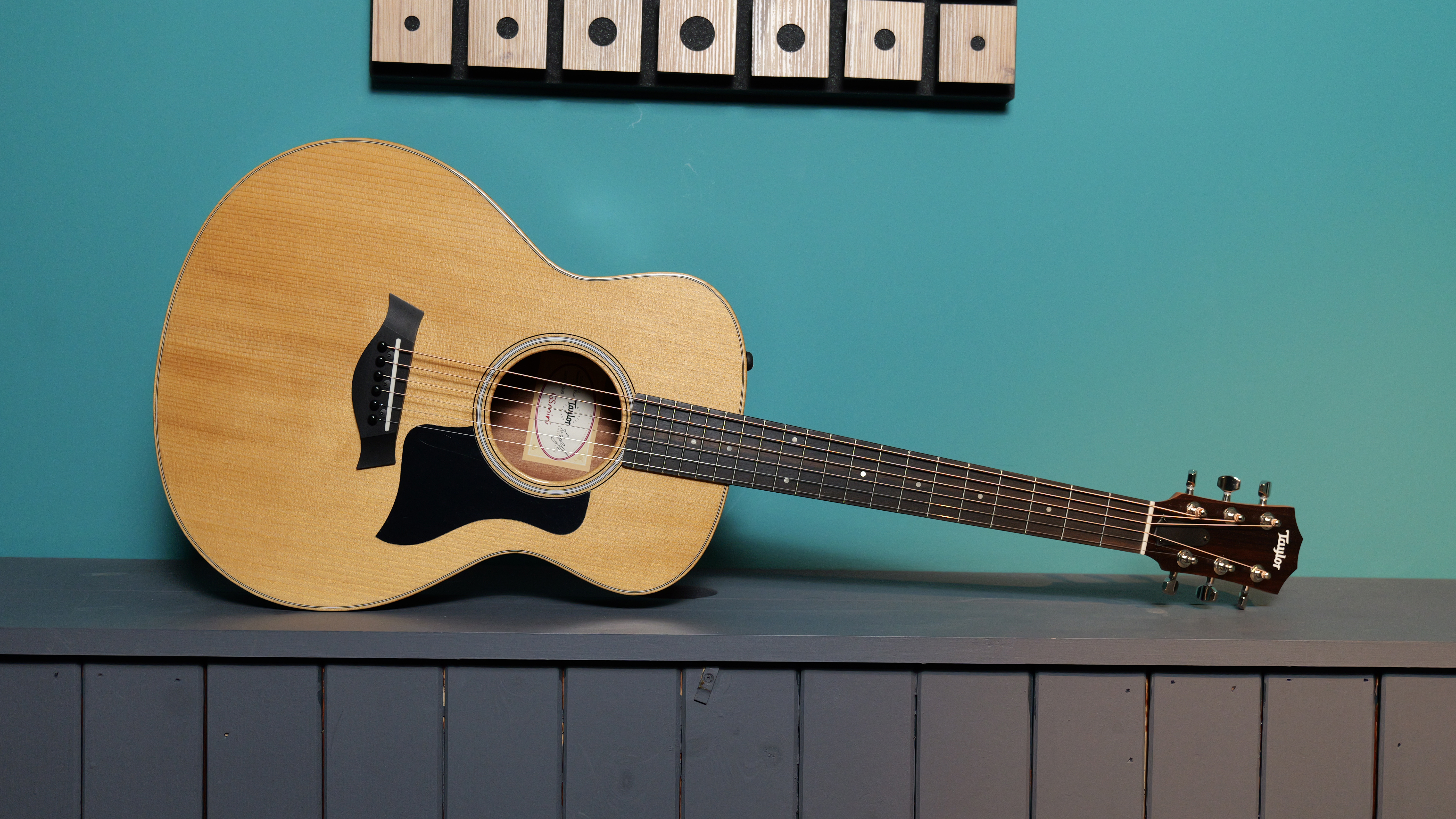
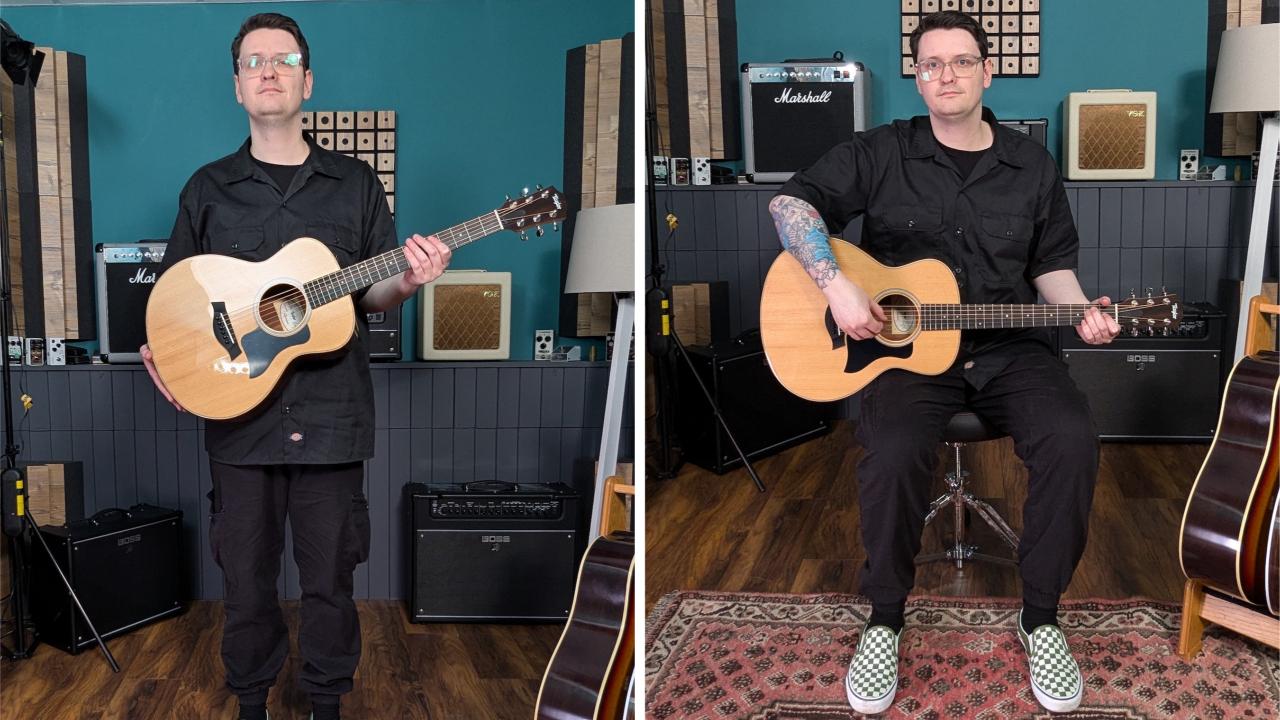



Specifications
Reasons to buy
Reasons to avoid
✅ Buy if you are seeking a comfortable small-body guitar: The Taylor GS Mini is a joy to sit with and incredibly comfortable for all ages.
❌ Avoid if you need a loud guitar: Due to the small nature of the body, this isn't the loudest guitar on this list.
Value: ★★★★☆
Playability: ★★★★★
Sound: ★★★★☆
Overall: ★★★★☆
In a nutshell: Taylor’s GS Mini doubles as a travel-sized guitar and dishes out all you need for home playing, especially for younger or smaller guitarists. The factory-set action is low, making it simple to play from the get-go.
Who is it for? This is a small guitar, making it ideal for kids. It also takes our top slot for the best guitar for small hands, as well as being our favorite beginner model for those looking for an electro-acoustic – the humble GS Mini can do it all!
Build: Examining the build quality of the GS Mini, it's evident that this guitar isn't intended for beginners. Yes, it's a fantastic option for newbie players, but this guitar is much more than an entry-level acoustic. The construction is rugged, the hardware top-notch, and the electronics superb.
Performance: I found the sound to be warm and clear, with a tendency towards the mid-range. Although the trebles are bright, despite their size, the bass is not lacking. The sound also includes ample sustain with notes enduring longer than would be expected from a ‘mini’. The onboard electronics deliver a stunning, amplified tone that rivals those of more premium models.
The broad tonal capability across the range makes it well-suited to a variety of musical styles, meaning this is one of the best acoustic guitars for beginners if you’re searching for tonal versatility as well as for an entry-level guitar that could last far beyond your newcomer years.
Watch my Taylor GS-Mini demo

“They say good things come in small packages, and Taylor can certainly attest to that with the GS Mini. Not only is this scaled-down guitar super fun to play, but I think it also has a sound that would rival some of its larger-bodied competitors.”
Read more: Taylor GS Mini Mahogany review
Spec comparison
Take a look at how our top choices compare, side-by-side.
Model | Retail price | Style | Solid Top | Electronics | Suited for |
|---|---|---|---|---|---|
Fender CD-60S | $199/£149 | Dreadnought | Yes | No | Adults/older kids |
Gretsch Jim Dandy | $189/£189 | Parlor | No | No | Kids/smaller players |
Yamaha FG800 | $229/£248 | Dreadnought | Yes | No | Adults/older kids |
D'Angelico Premier Gramercy | $249/£199 | Grand Auditorium | Yes | Yes | Adults/older kids |
Alvarez AD30 | $329/£249 | Dreadnought | Yes | No | Adults/older kids |
Taylor GS Mini-e | $699/£699 | GS Mini | Yes | Yes | Kids/smaller players |
Also consider
The above models are our top choices when it comes to the best acoustic guitars for beginners, but to compile the list, we had to review many more instruments. Below, you'll find a small selection of other beginner acoustic guitars that received positive reviews recently, but didn't quite make it into our top six.

Type: ‘Smart’ Acoustic | Top: AirSonic carbon fibre | Back & sides: AirSonic carbon fibre
Overall, the Lava ME Air surprised us. What ran the risk of being a toy-like guitar actually proved to be some serious fun, and the fact that we found ourselves immersed in the sonic side of it long enough to make us late for our deadline is probably the biggest benchmark.
Is it perfect? No, but it kept us playing. And in a world where ‘smart’ things turn our attention away from instruments, we can’t say fairer than that.
Read more: Lava ME Air review

Type: Dreadnought | Top: Solid Spruce | Back & sides: Mahogany
Based on its big brother from parent company Gibson, the ‘real’ Hummingbird would set you back closer to $3,000, so this one is a bargain - and easily one of the best acoustic guitars under $500.
We found the sound to be well-balanced and ideal for various styles, though the action, straight from the box, could be slightly lower to make it easier for beginners to play.
Read more: Epiphone Hummingbird Studio review

Type: Travel guitar | Top: Spruce | Back & sides: HPL
Don’t let the size fool you, though. Along with a brightness, in our test, the guitar provided surprising volume from the Sitka spruce top and mahogany laminate sides.
The high-pressure laminate also helps deal with heat and humidity changes, which is useful for frequent travel. Fishman Sonitone electric controls enable a relatively broad range of volume and tonal variety with a phase control to emphasize bass, which is useful when playing at lower volumes.
Read more: Martin LX1E Little Martin review
Glossary of key terms
Action: The height of the strings above the fretboard; low action makes it easier to play, while high action can give a louder sound.
Back & sides: Again, like the top, the back and sides of an acoustic guitar can be made from a variety of different woods. At this price point, you’ll mostly see laminate construction, as all solid guitars are generally a lot more expensive.
Binding: A decorative strip around the edges of the guitar body, neck, or headstock that can also provide structural support.
Body style: Acoustic guitars come in various shapes and sizes, from parlor and grand auditorium to dreadnought and jumbo. Typically, what is right for you at this stage in your playing career comes down to size.
Electronics: When we talk about electronics in the context of acoustic guitars, we refer to the pickup system, preamp, or even an onboard tuner. Of course, at this early stage of your playing, you don’t necessarily need a pickup, but if you have aspirations of playing live, you’ll want to consider a model with electronics.
Fingerboard: The fingerboard is the playing surface of the neck of the guitar. This can be made from everything from rosewood to walnut, Richlite, and pau ferro. Each brings their own characteristics to the table, and which you like most comes down to personal preference.
Saddle: A small piece of material (often bone or plastic) positioned on the bridge that supports the strings and helps with intonation.
Scale length: Simply put, the scale length refers to the distance between the top nut and the saddle on the bridge – and is used to measure the total playable length of the instrument.
Soundhole: The circular opening on the top of the guitar that allows sound to project out.
Top: The top of the guitar refers to the wood on the face of the instrument. This can be solid wood or a combination of woods, which we call a laminate top. The type of wood used for the top significantly impacts the tone of the guitar.
Tonewoods: Specific types of wood used in the construction of a guitar, chosen for their acoustic properties and contributions to sound quality.
Truss rod: A metal rod inside the neck that can be adjusted to control the neck’s curvature, allowing for adjustments to the guitar's action and playability.
How to choose the best beginner acoustic for you

If you're reading this guide, it's likely you're in the market for one of the best acoustic guitars for beginners, either for you or someone you know. In this section, I have gathered everything you need to know to ensure you make the right choice, from details about what to look for to buying advice specifically aimed at parents purchasing a guitar for their child. This is all based on my own experience of buying, selling and reviewing guitars over the last 10 years.
Now, before I get into the buying advice, I should also mention that the majority of the models showcased in this guide are available left-handed, so if you're a southpaw, you'll still be able to get your hands on one of our recommended guitars.
For starters, here's a bite-sized look at what to consider before you buy:
- Think about guitar size: do you need a baby acoustic, small-bodied acoustic, dreadnought or jumbo? Not sure what that means? I've cover the different guitar sizes further down the page. If you’re unsure what is the right size for you, just remember that you want to be able to get your right arm over the body comfortably, then, when seated with the guitar on your lap, you need to be able to reach to the end of the headstock without stretching.
- Are you buying a trusted brand? Fender, Epiphone, Yamaha, and Taylor are well-known brands and are great places to start.
- Does the guitar have a low action? This refers to the height of the strings above the fretboard – a lower action makes a beginner acoustic guitar easier and more comfortable to play.
- Do you want to play higher notes? You'll need a guitar with a cutaway in order to access the higher frets.
- Do you have a guitar tuner? A tuner makes a wise investment to keep your guitar sounding good, so I would recommend buying one at the same time as your new guitar.
- Do you want to amplify your playing? If you plan on playing live through a PA system at some point, you’ll need to retrofit an acoustic guitar pickup, or opt for an acoustic electric guitar that comes already fitted with electronics. My #6 option fits the bill for this.
- Harness the power of reviews: Once you've narrowed down your options, it's time to dive into the world of reviews. But remember, not all reviews are created equal. To get a comprehensive understanding of the guitars you're interested in, consult both professionally written editorial reviews and user reviews from forums. This balanced approach will equip you with the knowledge you need to make an informed decision.
Prefer to watch a video, than read a wall of text? Below, our very own Pete takes you through his top tips for selecting a beginner acoustic guitar.
FAQs

Who are beginner acoustic guitars for?
Beginner acoustic guitars are designed for individuals new to the world of guitar and are looking to start their musical journey. These guitars cater to a wide range of players, including children and adults. They are an ideal choice for those who are just beginning to learn how to play the guitar and are seeking affordable and user-friendly instruments to help them get started.
Whether it's a child taking their first steps in learning music or an adult looking to pick up a new hobby, beginner acoustic guitars are versatile and suited for anyone looking to embark on their musical endeavors.
In this guide, I've paid careful attention to the models we recommend to ensure we cover the full spectrum of players. There are smaller models for kids, budget-friendly options for adults, and even an electro-acoustic model for those aspiring to start gigging.
Are beginner acoustic guitars easy to play?
Relatively speaking, beginner guitars should be easy to play. If the guitar itself makes progress more difficult than it needs to be, you’re less likely to want to pick it up and practice. That means looking for a low action – the height at which the acoustic guitar strings are set above the fretboard.
While aiding comfort, a smaller-bodied guitar is also easier to play, especially for younger players or smaller guitarists.
While the body of a dreadnought guitar typically joins the neck at the 14th fret, providing easier access to the higher notes, the parlour guitar typically has a join lower down at the 12th. If playing the highest notes is important to the music you want to play, you may also want to consider choosing an acoustic guitar for beginners with a body cutaway below the neck.
Wondering if you should go electric? I've broken down the pros and cons of each guitar style in this in-depth feature: Acoustic vs electric guitar: which is best for beginners?
What are the different acoustic guitar sizes and shapes?
The first consideration you’ll need to make is the type of beginner acoustic guitar you're looking for, which will be primarily based on size and sound.
In my opinion, smaller-bodied acoustics are easier to play, and the size makes them more portable. By contrast, the larger the guitar’s body, the louder the volume and the bigger the tone it will produce. The most common acoustic guitar design, and the most versatile, is the dreadnought, which strikes the ideal balance between sound and playability.
At the opposite end of the scale is the jumbo acoustic, which produces greater volume, and the parlour guitar, with its small body and softer tone. Smaller still are mini or baby acoustics.
You’ll find a mix of the above in my best beginner acoustic guitars guide, and of the three main designs, there are various spin-off styles too. Tried and tested brands in this area include Fender, Epiphone, and Yamaha, and Taylor and Martin are notable brands at the more premium end.
How do I tune a beginner acoustic guitar?
I've found that tuning is typically a challenge for beginners, so guitar tuners, which ease the process and help you retain correct tension, are a vital accessory for me. If your budget is tight, there are plenty of great, affordable clip-on guitar tuners on the market, too. These are small, relatively inexpensive, and easy to use.
If you get really stuck, I've compiled this handy step-by-step guide showing you how to tune a guitar.
How much should I spend on a beginner acoustic?
Once you've worked out exactly what you need from your beginner acoustic you can start to figure out your budget. I'd certainly suggest you avoid the sub-$100, non-branded options you'll find on sites like Amazon. You'll quickly outgrow them and you'll run into issues like poor tuning stability, less than ideal action and poor sound.
As the guitars in this guide prove, you can get your hands on a seriously well-equipped beginner acoustic for around $150. In fact, set a budget of between $150 and $250 and you'll walk away with a guitar that you will happily play for a few years without needing to upgrade.
Up your budget a little further and you can expect better components, improved tone and you may even get electronics as part of the package.
Where is the best place to get beginner guitar lessons?
Picking up one of the best acoustic guitars for beginners is no use unless you know how to play at least the basics on it. Some people are able to pick things up by ear, or are lucky enough to have someone in the house to show them the ropes. If neither of these apply, I would always recommend taking lessons if you're able.
Face to face lessons are a great way to build a bond with a teacher and develop your skills in a hands-on way, but if you want to quickly understand basic guitar techniques, learn from the comfort of your home and don't have a huge budget, online lessons are a great, affordable route to take. You can learn more and discover our favorites in this guide to the best online guitar lessons.
You can currently make savings on a some of those platforms using the codes below, too.
- Guitar Tricks: Get your first month for just $1
- Simply Guitar: Save 20% at this link
- TrueFire lessons: Save 30% with code GWTF30
Where is the best place to buy a beginner acoustic?
When it comes to buying your very first acoustic guitar, it's important to buy from a well-respected site or store. Now, while there are myriad music retailers out there, I only recommend the shops and sites I trust and have had experience dealing with personally.
In the US, I highly recommend taking your custom to Guitar Center, Musician's Friend, Sweetwater and Fender. These sites always have competitive prices and, more importantly, they each have excellent customer service and generous returns policies.
In the UK, start with Thomann, Fender, and Gear4Music. Again, these sites always deliver when it comes to excellent prices, while also providing stellar customer service.
When should I buy a beginner acoustic guitar?
You may feel like there's no better time to shop than Black Friday, Amazon Prime Day, President’s Day or Memorial Day. And while it's certainly true that the Black Friday guitar deals are often pretty remarkable, the truth is, beginner acoustic guitars are regularly on offer throughout the year.
You can expect to see significant price drops on big-name brands, heavily discounted bundle deals, and clearance offers even outside of annual sales events.
So if you are in the market for your first beginner acoustic guitar, we don't suggest waiting around. Head over to your preferred retailer and see what offers they have on right now, or better yet, let our clever price widgets show you the best deals available from across the internet.
Do I need to test out the guitar at a store?
As a former music store employee, I understand that visiting a guitar shop can be daunting, especially for beginners. However, I want to reassure you that most shop staff are not only welcoming but eager to help you find the perfect beginner acoustic guitar.
Their goal, and mine, is to ensure you leave with a guitar that suits you best and becomes the catalyst that ignites your passion for music. Now, it's not totally necessary to test out the guitar in person, as many retailers have excellent returns policies and superb customer service.
However, many players do prefer to get hands-on with a guitar before purchasing. So, if you feel like testing a guitar in person would be helpful, but you're feeling nervous about it, be sure to check out my in-depth guide to how to test a beginner acoustic guitar in a guitar store.
Should I use user reviews, forums and influencers to help me find a beginner acoustic?
When searching for the best acoustic guitar for beginners, it's essential to gather information from various sources. User reviews and forums can provide a good indication of how the guitar performs for beginners. However, keep in mind that it's also valuable to consider professional reviews and unbiased opinions.
Professional reviews offer in-depth evaluations of aspects such as the ease of play, craftsmanship, the type of wood used, and how it compares to other guitars on the market. These reviews examine key factors that may not be evident in user reviews alone.
By taking into account both user experiences and expert evaluations, you can make a well-informed decision when choosing a beginner acoustic guitar that fits your needs and preferences.
Advice for parents

It can be daunting for parents to pick out the best acoustic guitar for beginners. You don't want to make the wrong choice and make learning more difficult for them, or worse, put them off the instrument completely.
But hey, don't stress! I've got your back with some handy tips.
Pay careful attention to the size: Guitars come in various shapes and sizes, so it's important to select the correct one for your child. As a general rule of thumb, you want to make sure your little one can easily reach the end of the neck while in the seated position without stretching too much. Typically, we suggest that under-12s opt for a short-scale or 3/4 guitar, and for 12 and up, we recommend a full-sized instrument.
Price vs quality: When it comes to beginner acoustics, you really don’t need to spend too much to get a great instrument. That said, you want to ensure that you are buying the best quality instrument you can afford. The better the instrument's build quality, the better it will play and the more chance your little one has of sticking with it!
Don’t forget the accessories: To give your child the best possible chance of sticking with the guitar, you’ll want to ensure they have everything they need to play properly. A selection of guitar picks, a spare set of strings, a guitar strap, a guitar tuner, and a gigbag for carrying it around to and from lessons are all must-have accessories.
Looking for more advice? My parent's guide to buying a guitar for your child, is the place to go for more top tips.
Why trust Guitar World?

☑️ A global audience of 3.8 million guitarists monthly
☑️ 1,200+ reviews on GuitarWorld.com
☑️ 30+ years of product testing at Guitar World
Guitar World boasts over 44 years of expertise and stands as the ultimate authority on all things related to guitars. The magazine and website feature expertly written gear round-ups and top-quality, authoritative reviews penned by a team of highly experienced industry professionals.
Guitar World's inaugural print issue hit the shelves in July 1980, and ever since, it has been captivating players and enthusiasts with engaging lessons, insightful interviews with the biggest guitar heroes, and priceless buying advice for newbie players.
Furthermore, GuitarWorld.com continues this legacy online and serves as the hub of the world's foremost authorities on guitar playing. The site not only hosts content from Guitar World but also showcases articles from respected publications such as Guitarist, Total Guitar, Guitar Techniques, and Bass Player. With a reach extending to 3.8 million players each month, GuitarWorld.com is a go-to destination for guitar fanatics globally.
Below, you'll find more information about the expert authors and reviewers who helped put this page together.

I'm Guitar World's Senior Deals Writer. In this role I create and maintain the 200+ buyer's guides you'll find on the site, find the best deals on guitar products for our readers, and test the latest gear. My reviews have been featured in prominent publications including Total Guitar, Future Music magazine and MusicRadar.com.
During my career, I have been lucky enough to talk to many of my musical heroes, having interviewed Slash and members of The Offspring, Foo Fighters, Sum 41, Thrice, and more. Prior to joining the Guitar World team, I worked in music retail, at Kenney's Music in Dundee, Scotland. For a decade, I advised everyone from absolute beginners to seasoned pros on the ultimate gear for their needs, from beginner acoustic guitars, to top-end modelers.

Stuart has been working for guitar publications since 2008, beginning his career as Reviews Editor for Total Guitar before becoming Editor for six years. During this time, he and the team brought the magazine into the modern age with digital editions, a Youtube channel and the Apple chart-bothering Total Guitar Podcast. Stuart has also served as a freelance writer for Guitar World, Guitarist and MusicRadar reviewing hundreds of products spanning everything from acoustic guitars to valve amps, modelers and plugins.

Jonathan Horsley has been writing about guitars since 2005, playing them since 1990, and regularly contributes to publications including Guitar World, MusicRadar and Total Guitar. He uses Jazz III nylon picks, 10s during the week, 9s at the weekend, and shamefully still struggles with rhythm figure one of Van Halen’s Panama.

Chris Corfield is a journalist with over 12 years of experience writing for some of the music world's biggest brands including Orange Amplification, MusicRadar, Guitar World, Total Guitar and Dawsons Music. Chris loves getting nerdy about everything from guitar gear and synths, to microphones and music production hardware.

After spending a decade in music retail, I’m now a freelance writer for Guitar World, MusicRadar, Guitar Player and Reverb, specialising in electric and acoustic guitars, bass, and almost anything else you can make a tune with. When my head’s not buried in the best of modern and vintage gear, I run a small company helping musicians with songwriting, production and performance, and I play bass in an alt-rock band.
How we test beginner acoustic guitars

When it comes to beginner acoustics, every player has their own personal preferences regarding the tone and feel. That said, regardless of taste, there are a few key criteria that a beginner acoustic guitar must meet before myself and our testing team feel comfortable recommending it.
When we receive a guitar for review, we start by asking ourselves the following questions:
- How easy is the guitar to play for a complete beginner?
- Does the guitar sound inspiring?
- Is this model well-made and robust?
- And does the guitar offer the player good value for money?
Below you'll find a breakdown of the tests we carry out to answer each of these questions.
Build quality: Like with all instruments, we first examine the overall build quality. We closely inspect every inch of the guitar, from the body and neck to the machine heads, bridge, and saddle, to ensure it feels robust and sturdy and ready to take you on your musical journey.
Playability: We'll next check the consistency of the fretwork to confirm there aren't any sharp frets or uneven frets that may result in buzzing. This ties into the guitar's playability. For us, the guitar should be comfortable for someone completely new to the instrument, and this means a reasonably forgiving neck and unobtrusive body.
Sound: Next, we turn our attention to the sound of the beginner acoustic guitar. To test the tone of the instrument, we will try a variety of different playing techniques and styles to see how the guitar handles them, from strumming wide-open chords with a flat pick to soft fingerpicking and everything in between. We are carefully listening to the volume the guitar produces and the overall tonal balance of the sound.
Value: Lastly, we'll carefully combine our thoughts on all the above sections – from design and performance to sound – and weigh them against the acoustic guitar's price to determine whether it's worth the investment. After all, finding the perfect balance between quality and affordability is key to choosing the right beginner acoustic guitar for your needs.
Find out more about how we make our recommendations and how we test beginner acoustic guitars.
How we shoot our product demos

One of the most significant factors to consider when choosing your first guitar is the sound it produces – that’s why I've recorded and filmed a short playing demo of every guitar in the guide. That way, you can make an informed decision based purely on which model you think sounds the best.
In order to keep things simple, I performed the same chord progression on every guitar at three dynamic playing levels. First, I strummed the guitar with a plectrum to show off the instrument's volume range. Next, each note was picked individually to display the guitar's note clarity. Lastly, I ditched the pick and used my fingers to see how the guitar reacted to the subtle nuances of fingerpicking.
Myself and the team recorded the video demos in our dedicated studio in Bath, UK. If you’re a regular consumer of guitar content on YouTube, you may recognize this space as the famous Guitarist Tone Lounge.
Now, to ensure the most natural tone possible, we used a simple crossed microphone technique – known as the X-Y technique – to capture the exact sound in the room. We used a pair of Austrian Audio CC8 condenser mics for this. In my opinion, this humble stereo microphone set-up typically produces the most true-to-life sound, perfect for hearing the guitar as you would if you were the one playing it.
As you’d expect, we did apply some post-processing to the audio once it was captured, but we kept this to a minimum. A little compression was applied to help keep the volume levels consistent throughout the demos, and EQ was used to cut “boomy” frequencies that built up in the room. Lastly, we added a touch of digital reverb to add a sense of depth to the recording.
Latest updates
21/10/25: New images and video added to our top pick, the Fender CD-60S, as well as an extended glossary and FAQS.
21/08/25: The page has been audited to ensure we are still recommending the very best acoustic guitars for beginners. We've also added a "how to choose" video to better help you make the right purchase.
18/02/25: We've gone through and thoroughly checked our choices to ensure we are still happy that we are recommending the very best beginner acoustic guitars on the market right now and the models most worthy of your cash.
10/10/24: We have completely overhauled this page, adding demo videos for each guitar, sizing guide photos so you can get a better sense of the scale of each guitar and added more in-depth information and clarity to our buying advice section.
Read more:
You can trust Guitar World
- Just starting out? Check out the best beginner classical guitars
- Play more comfortably with the best guitars for small hands
- The best guitar straps for boosting playing comfort
- Plug in with the best beginner electric guitars
- Gear up with these guitar accessories for beginners
All the latest guitar news, interviews, lessons, reviews, deals and more, direct to your inbox!

Daryl is a Senior Deals Writer at Guitar World, where he creates and maintains our 200+ buyer's guides, finds the best deals on guitar products, and tests the latest gear. His reviews have been featured in prominent publications like Total Guitar, Guitarist, Future Music magazine, and MusicRadar.com.
During his career, he has been lucky enough to talk to many of his musical heroes, having interviewed Slash and members of Sum 41, Foo Fighters, The Offspring, Thrice, and more. In a past life, Daryl worked in music retail. For a little under a decade, he advised everyone from absolute beginners to seasoned pros on the right gear for their needs.
Daryl is a fully qualified sound engineer, holding a first-class Bachelor's degree in Creative Sound Production from the University of Abertay.
- Stuart WilliamsDeputy Reviews Editor





